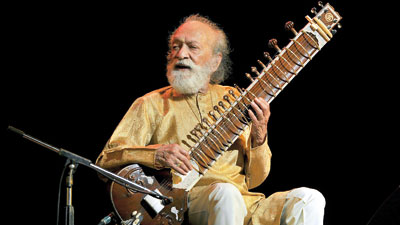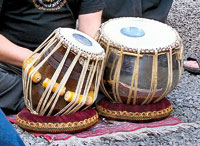Sunday Times 2
Historic note on the music of the Mughals
The Mughal Period in the history of the Indian Sub-Continent had witnessed an unparalleled emergence of a new cultural heritage encompassing all that was good in that era about 900 years ago. Persian, Turkish, Arabic and the native cultures inter-mingled (sangam) with each other, creating a new vibrant, sophisticated, and civilized pattern, spreading over a wide spectrum of human life. Architecture, literature, music, art, language, cuisine even dress acquired a new form and shape that is sublime and beautiful.
 But indeed among all these contributions of the Great Mughals, music occupies the pride of place. The ingenious adaptation of Persian and Turkish musical pattern into the existing Raga-Ragni system, literally revolutionised the “Baratiya Sangeet”. The Indian musicologists of the highest repute, Shri Laxmi Narayan Garg and Pundit Bhatkhande agree that the present day music system in the Northern part of the Indian sub-continent is undoubtedly the creation of the Mughal musicians, the pioneer of whom was none other than Amir Khusru, who adorned the courts of Alauddin Khilji, in 1250.
But indeed among all these contributions of the Great Mughals, music occupies the pride of place. The ingenious adaptation of Persian and Turkish musical pattern into the existing Raga-Ragni system, literally revolutionised the “Baratiya Sangeet”. The Indian musicologists of the highest repute, Shri Laxmi Narayan Garg and Pundit Bhatkhande agree that the present day music system in the Northern part of the Indian sub-continent is undoubtedly the creation of the Mughal musicians, the pioneer of whom was none other than Amir Khusru, who adorned the courts of Alauddin Khilji, in 1250.
From this period onwards, a new concept of music began to emerge. Initially the native Indian music was devotional and part of temple activities. Hence it was called Temple Music. The greatest achievement of that multi-faceted genius Amir Khusru was to take this form of music and adapt to suit the regal splendour of the darbars of the Mughal emperors. At this juncture it is important to mention that almost all the Mughals were lovers of music. It was their unstinted Royal patronage to music and musicians that helped the development of the many intricacies, innovations and embellishments in the Raga-Ragni system.
Amir Khusru’s father was a Turk and mother Indian, hence he inherited all that was Indian, Turkish and Persian as it was the royal language. His deep knowledge in the Raga system formed the basis of musical creations such as Ghazal, Quawwalis, Tarana Khamsa, Khyal and many more. He developed new raga such as Zilaf, Sazgiri, Sarparda, Yaman, Rat ki Purya, Barari Thody and Poorvi. Among the Thalas he innovated Jhoomra, Ada Choutal, Sulfak, Pashto, Farodust and Sawari were salient. The most enduring innovation was the creation of Sitar and Tabla which are capable of producing the most scintillating and captivating musical sound.
These two instruments occupy the pride of place in the Mughal music, and gradually acquired a place as international instruments. They are being liberally used in the Western Pop as well as classical. All that Amir Khusru did was to take the South Indian Veena and modified to suit the darbar atmosphere: Reduced the strings from four to three, added more strings on the side for more vibrations, made the immovable frets of the Veena to movable, and minor changes in the shape and the result was astonishing. Sound became sweeter, enabled the artiste to reach fast rhythm, move the frets to accommodate Komala and Teevra (flat and sharp) notes. In general, Sitar provides the artiste to exploit the Raga and the instruments to the maximum.
Tabla too underwent the similar modifications on the South Indian percussion instrument Mirdangam (Pakhwaj in the North). Since this percussion is too loud and noisy, which is a bit jarring in the darbar atmosphere, Amir Khusru cut it into two pieces made it “Dayan and Bayan”. The result was soft sound, faster and intricate rhythm, and easy handling.

Tabla came from Miruthangam
Therefore, Amir Khusru can easily be called the father of Mughal music. He had made his name immortal in the music world. After Amir Khusru there had been a long line of Mughal musicians who contributed enormously to the development of music. They included even the Badshahs. Badshah of Jounpur, Sultan Husain Sharki (1458-1499), an able musician himself, developed the style of Khyal singing (kalawanthi). He created new ragas like Jounpuri-Thodi, Sindhu-Bhairavi, Rasul-Thodi, and 12 different variations of Shyam, Jounpuri and Sindhura.
During the 16th Century (1556-1605) when the Mughal-e-Azam (the Great Mughal) — Akbar Jalaluddin Zille-Ilahi — was the Badshah of Hindustan, one of the greatest musicians called “Thansen” adorned his courts. He was one of the jewels of the Akbar’s court, and a royal musician. The great musicologists and even practising musicians without any exception accept that Mian Thansen (fondly called Miyan) had the perfect voice production in the sub-continent. His handling of ragas was considered the most perfect. The notes of the rages fall exactly in the fixed frequencies. The voice of Miyan Thansen was so perfectly trained that it could imitate and modulate his vocal cord to produce all frequencies audible to human ear. There were stories depicting his feats, like creating fire, bringing rain, roaring like a lion. A conspiracy was hatched to destroy Miyan Thansen by the fellow musicians, forcing him to sing Raga Deepak. In spite of his refusal, his wife, who was equally a great singer had to come and sing Raga Malhar which extinguished the fire. However, later Miyan Thansen succumbed and died.
His contribution to the Moghal music was unparalleled. He developed many ragas such as Darbari-kanada, Miyan-ka-Sarang and Miyan-ki-Malhar. He left behind many pupils who carried the torch of Tansen-Gayeki, Rababiye Wazir Khan and Mohamed Ali Khan of Rampur.
During the time of Badshah Jahangir (1605-1627) there were illustrious musicians in his darbar. Few of them were Bilas Khan, Chattar Khan, Khur-e-Mad Maqu-khu, Parvez Daad, and Hamadan.
Emperor Shah Jahan (1628-1658) himself was a musician of great repute. His Urdu songs were much appreciated, because the Urdu language and musical melodies blended so well. He was a great lover of music and employed many musicians. Thirang Khan and Lal Khan were his favourites, Emperor Shah Jahan loved their music so much that the Emperor gifted silver equal to the weight of the musicians.
During the 18th Century, Badshah Mohamed Shah Rangeele was on the Mughal throne (1719-1740). He was another great lover and patron of music. In his Darbar there were two great singers called “Sadarang and Adarang”. These musicians composed thousands of “Khyal”. The Khyal Gayaki became popular during their period. Many of their compositions or Khyals carry their names at the end. They also left many worthy musicians to continue their Gharana.
As late as 1813, there lived a musician and musicologist by the name Mohamed Reza. He hailed from Patna, Bihar. He had written a treatise on music “Naghmate Asfi”. In his book he formulated a new theory of ragas and raginis. He accepted only six ragas and thirty six raginis as melas (parent ragas).
In modern times close upon 1911, another musician and musicologist by the name of Raja Nawab Ali Khan lived in Lahore. He too wrote a valuable book on music titled “Ma’rifunnaghmat”, in Urdu Language, which today being used as text in many examinations.
When we come to the modern times, we have a long line of illustrious Mughal musicians. They formed into different Ghranas (schools), jealously guarding the secrets of the special rendering of ragas. The most popular of them are, Gwalior Gharana, Patiyala Gharana, Kinnara Gharana. “Aftabe Musique Faiyaz Husian sahib enriched the Gwalior Gharana. Ustad Bade Ghulam Ali Khan was from Patiyala Gharana, Usted Abdul Karim Khan was from Kinnara Gharana.
Ustad Allauddin Khan of Maihar a musical sage contributed the most by giving three musical gems to the world of music. He himself was a master musician and played a variety of instruments, western and eastern. His son was Ali Akbar Khan, the foremost sarod player during his time. The illustrious sitar nawaz Ravi Shankar, Pundit Panna Lal Ghosh, a master flute player; were Allauddin khan’s students.
There are many more great musicians who enriched Mughal Music. Among them were the great sitar nawaz Ustad Vilayat Khan, and renowned singer Ustad Vilayat Hussian Khan of Bombay.
It is heartening to see this form of music is being popularised in Sri Lanka too; through various institutions. They are doing a yeomen service indeed to propagate the music of the Mughals.
(The writer is a retired Director of Radio Ceylon – SLBC)

